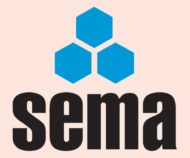Our first question this month is asking for guidance on column guards and our second is for Fitting Back Mesh on a Single Run.
 Column Guard Guidance
Column Guard Guidance
Q. Can you tell me if any guidance exists from SEMA that sets out dimensions for column guards? We have a lot of guards to install and have been asked what the standards are.
A. Protection is required to corner uprights between a transfer aisle and an aisle and to corner uprights between a drive through bridge bay and an aisle. Protection is also required for the rear uprights and frame bracing where goods are stored at the ends of a run.
Protection is recommended for the rear uprights and frame bracing at each side of a drive-through bridge bay.
Protection of internal uprights within an aisle is optional and shall be based on the risk assessment.
Retrofitting upright protection to an existing aisle where they have never been provided can have the effect of reducing the available clearances for fork-lift truck manoeuvres, which can in some circumstances, increase the amount of damage caused. Such situations need consideration on a case-by-case basis.
The SEMA Code of practice for the design and use of racking protection recommends that corner and in-aisle protectors shall be a minimum of 300mm high from the floor level.
The purpose of the protector is to absorb kinetic energy from a moving truck. This is generally done by the protector material distorting and absorbing the energy. Each manufacturer offers different recommendations relating to their product depending upon the design of their particular upright protector so there is no standard guidance.
It is probable that floor fixed protector testing will result in a typical distance between the upright and protector of between 25mm and 75mm and it is recommended that a clearance zone of at least 25mm should be provided between the upright / bracing and the protector. However, only the supplier, who should have carried out performance tests, will be able to confirm the effectiveness of his particular guard, and inform you of the recommended clearance for a particular design.
Fitting Back Mesh on a Single Run
Q. Is it mandatory to fit mesh to the back of a single run of racking or is it primarily for safety reasons?
A. As far as we are aware there is no specific requirement that single runs should be back clad. The necessity for this depends upon the risk assessment for the situation and operations taking place.
It can often be good practice to do this as it is not unusual to have perhaps an order packing area, or a goods return area, or even to have a walkway behind the last run of racking in a block. In such cases rear cladding will probably be needed to protect the people involved from possible injury. We are unaware of any requirement that makes it mandatory to fit mesh in a situation where there is little or no risk, however.
From the same point of view if double deep or other rack types are presenting similar risks to persons involved then, where those risks could be eliminated or reduced by the use of mesh or other means then there is an obligation on those involved to reduce those risks as far as possible.
SEMA Annual Safety Conference 2020 – a date for your diary
The 2020 SEMA Safety Conference has been scheduled for Thursday, 5 November; the venue will be the National Motorcycle Museum, Solihull.
For full details and a booking form contact SEMA at enquiry@sema.org.uk
SEMA Technical Enquiries
We hope you find the above articles, and those in previous editions, interesting. If you have a query send it to us by fax or email and we will do our best to have it answered by one of our technical experts.
SEMA Rack Safety Awareness and Inspection Courses
SEMA runs a one-day safety course on Rack Safety Awareness and Inspection. These courses are aimed at end users, giving an in-depth look at the need for inspections, how to conduct an assessment and what actions to take when this is completed. These courses are normally held at the SEMA headquarters but arrangements can be made to hold them at the delegates’ premises.
SEMA Approved Rack Inspectors Qualification
This qualification is aimed at professionals who conduct rack surveys as an integral and significant part of their duties. It involves delegates in undertaking an in-depth SEMA Course, together with an examination and practical assessment. CPD will be an important part of the qualification, demonstrating to end users that SEMA Approved Inspectors maintain a high professional standard.
SEMA Publications
SEMA has 26 publications in stock – Codes of Practice, ‘Guides’ and European documents – all of which are available from our Offices. For further information on these documents contact SEMA or visit our website, www.sema.org.uk. and click on ‘Codes of Practice’.
SEMA USERS Club
SEMA runs a USERS Club designed to be of benefit to purchasers and users of storage equipment. Members receive newsletters, access to specialised events and discounted rates on publications and codes of practice.
SEMA




Comments are closed.